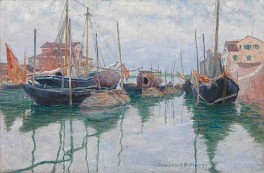BIOGRAPHY

American, 1860-1899
Artist Biography
John Leslie Breck, recognized in his day as the first American impressionist, grew up in the Boston area. Born at Sea near the pacific Island of Guam, John Leslie Breck was the son of a Massachusetts navy captain. He lived in San Francisco until his fathers death in 1865 when his mother moved the family to Boston. His Family’s affluence afforded him the opportunity to pursue his artistic interests. Beginning in 1877, he studied at the Munich Royal Academy, under Alexander Straehuber. He continued his training in 1881 with Charles Verlat in Antwerp. He returned to the United States from 1882 to 1886. In 1887 Breck began working in Giverny and became quite close to Monet and his family. From then on, according to art historian Kathryn Corbin, the "dark and studied paintings influenced by his time in Munich were replaced by exuberant, light-filled landscapes . . . ." in 1889 he showed two paintings in the Exposition Universelle, Paris and was awarded an honorable mention. After he returned to Boston, he presented a one-man show at the St. Botolph Club in 1890 that introduced impressionism to the Boston art world.
However, of the many American painters who spent time at Giverny in 1887, Breck and Theodore Robinson “were the two who became closest to Monet.” … For a time Breck must have appeared as Monet’s most promising artistic heir among the Americans. His Garden of Giverny is one of the first Impressionist flower garden paintings among the American artists.
Breck traveled to Venice in 1896, following his critically successful second solo exhibition in Boston. Like many American painters of his day, he found himself drawn to the genteel decrepitude of the Venetian landscape, which remained untouched by industrialization. As scholar Margaretta Lovell has observed, Venice held particular appeal for American artists of this generation including Sargent, Prendergast, Whistler, and Thomas Moran.
In its poetic remoteness from bourgeois urban existence, Venice was the civilized counterpart of the unsettled West, the rugged Andes, and the frozen polar regions, which also became important subjects for Americans during this period. To these artists, Venice, the distilled essence of the past, represented human history. [“American Artists in Venice, 1860-1920,” The Magazine Antiques, April 1985, p. 864]
A favorite haunt of American painters, the Giudecca Canal flows between Venice’s main grouping of islands and the smaller, sleepier Giudecca Island. Giudecca historically served as home to Venice’s fishing industry, providing the painters who worked there with boundless opportunity to capture views of the tradition-bound fisherman and their picturesque craft. Breck produced a number of Venetial works in the year following his visit there, which, as Benjamin Kimball commented, “show his command of brilliant and harmonious color” [in Memorial Exhibition of Paintings, p. 2]
EDUCATION:
1877, Munich Royal Academy, Munich, Germany.
1881, Trained with Charles Verlat in Antwerp.
